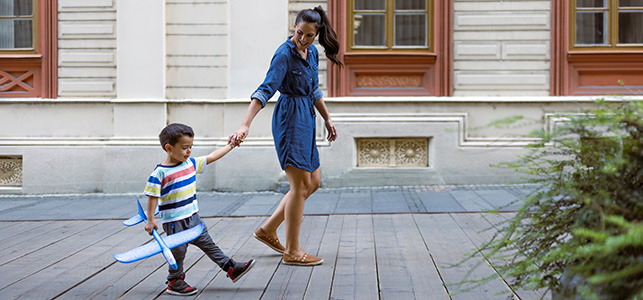
Gait evolves as kids grow
Sometimes awkward walking patterns follow toddlers’ adorable, wobbly first steps. The good news is most are a normal part of development and evolve as kids’ bodies grow.
The most common gait abnormalities in young kids tend to be in-toeing, toe walking, bowlegs and knock-knees. Dr. Victoria Kuester, Beverley B. Clary Chair of Pediatric Orthopaedics, explains why each may occur and when you can expect your child to outgrow them.
What is in-toeing and how long is it considered “normal?”
In-toeing, sometimes called walking pigeon-toed, is typically due to a curvature of the foot or rotation of the leg bones.
- In little ones younger than 18 months, the most common cause of in-toeing is the front part of the foot turning inward, likely because of positioning in the womb. This usually improves without treatment but if it is not improving by a year, casting or special shoes may help.
- Between 18 months and 3 years, in-toeing is most commonly caused by internal tibial torsion, or an inward rotation of the tibia bone in the lower leg. In most cases, the tibia will naturally rotate outward as the child grows during their first few years of life. Special shoes or braces do not help it to improve any faster.
- The position of the thigh bone, or femur, is the most likely culprit of in-toeing in kids between 3 and 8 years old. The femur is rotated inward about 40 degrees at birth. This inward twisting of the femur, called femoral anteversion, causes the knees and feet to also turn inward. In nearly all cases, this angle decreases to about 15 degrees as the child grows and matures by the age of 10. Even if the angle doesn’t improve, it doesn’t typically cause medical problems like pain or arthritis and only needs treatment if it remains a functional problem, which is seldom.
Out-toeing is walking with the feet turned outward. It’s most commonly caused by external tibial torsion (versus internal for in-toeing) or femoral retroversion (versus femoral anteversion for in-toeing).
In-toeing and out-toeing usually resolve on their own between toddlerhood and age 10, depending on the reason.
Why do some kids walk on their toes?
Toe walking, or walking on the balls of the feet, is fairly common when learning to walk. As toddlers become more confident in their balance, they usually begin to follow the typical heel-to-toe pattern.
When toe-walking lasts beyond age 2, it’s often because of habit. It may also be that the child’s calf muscles and tendons have tightened over time, making it painful for their heels to touch the ground when walking. In rare cases toe-walking can be a sign of an underlying medical condition such as cerebral palsy or muscular dystrophy.
If kids continue to have normal range of motion of the ankles and no signs of any neurologic problems, we usually wait and allow them to outgrow the habit for a few years without treatment.
What causes bowlegs and knock-knees in young children?
Bowlegs and knock-knees are normal at certain ages in young kids as their muscles are developing.
In the case of bowlegs, the legs curve outward at the knees and back inward at the ankles in a symmetric way. They’re not painful and don’t typically cause any difficulties with walking, running or playing. Bowlegs could be a sign of a growth or metabolic disorder, but this is rare. Bowlegs should be improving by the time your child turns 2. If they are not, they should be seen by a specialist.
Knock-knees occur when the knees turn inward and touch, or “knock,” while the ankles are apart. They’re often part of normal bone growth and development during the toddler years. Similar to bowlegs, knock-knees don’t usually cause pain or interfere with the ability to move and play. Kids usually outgrow knock-knees by the time they’re 6 or 7 years old.
What can be done about a child’s abnormal walking pattern?
When children first start crawling or walking, they frequently have an asymmetric pattern. The most likely course of action for situations that aren’t painful or causing difficulties with walking and development is to watch and see if the gait naturally improves over time. If the asymmetry does not improve, you’re concerned about your child’s walking or they’re having pain, talk with their pediatrician.
There are a few steps that can be taken in the interim or if improvement doesn’t occur on its own. Physical therapy can help with muscle strengthening and stretching, as well as balance. Casts, braces and special shoes can also help with foot and leg positioning in some situations. We typically recommend surgery only in cases when, without it, a child’s gait will continue to worsen and prevent them from walking safely and comfortably as they get older.
Some gait patterns tend to run in families and many people in-toe, out-toe or have other walking differences into adulthood. As long as they don’t limit movement and abilities, they don’t need to be taken care of unless the individual opts to do so.
